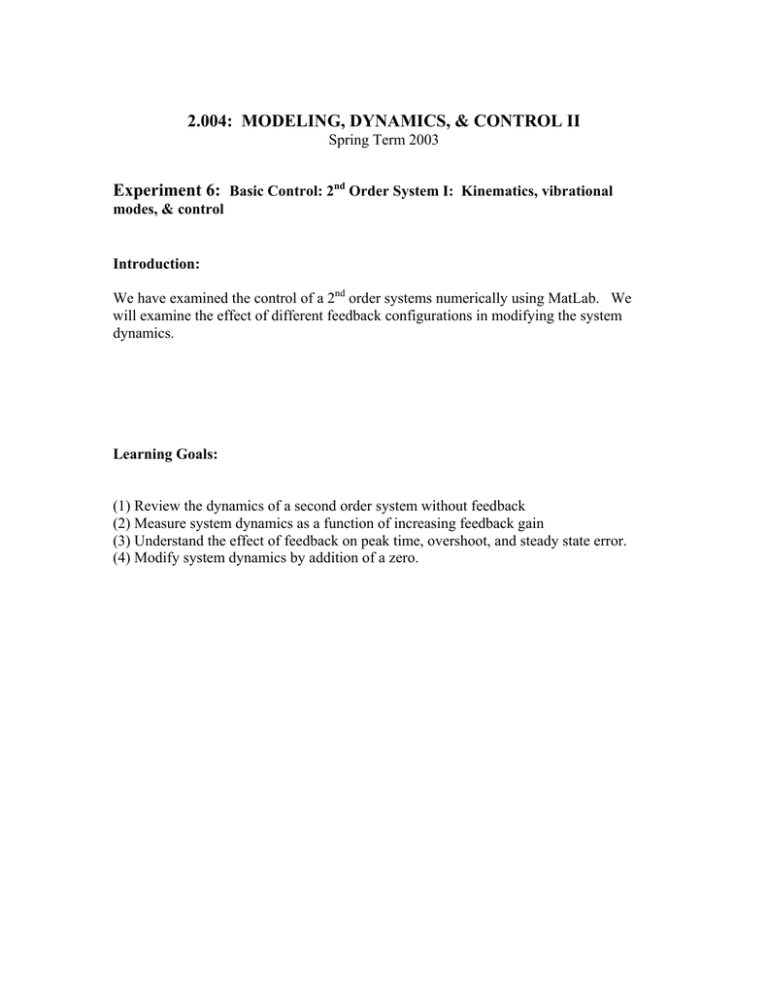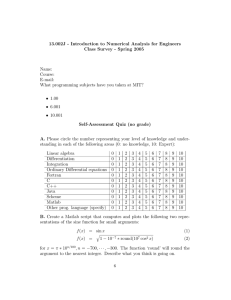2.004: MODELING, DYNAMICS, & CONTROL II Experiment 6:
advertisement

2.004: MODELING, DYNAMICS, & CONTROL II Spring Term 2003 Experiment 6: Basic Control: 2nd Order System I: Kinematics, vibrational modes, & control Introduction: We have examined the control of a 2nd order systems numerically using MatLab. We will examine the effect of different feedback configurations in modifying the system dynamics. Learning Goals: (1) Review the dynamics of a second order system without feedback (2) Measure system dynamics as a function of increasing feedback gain (3) Understand the effect of feedback on peak time, overshoot, and steady state error. (4) Modify system dynamics by addition of a zero. Experimental procedures: A steel rod, mass m, is riding on air bearings. The air bearings constraint the rod to move linearly. The rod is driven by a voice coil with force f. The voice coil not only provides the driving force but also acts as a damper with damping coefficient, γ. The steel rod is further coupled to a spring with coefficient k. The position of the rod is measured using a LVDT. Key experimental parameters are: m = 0.85kg 0.132 N k= l3 m γ =( K2 + c) R l = 50mm K = 7.1 N A R = 5.5Ω c=5 Ns m The output of the signal generator should be set between 0 and 2 volts. Set the frequency synthesizer to an appropriate frequency such that the positional response of the system response can be accurate measured. Task 0: Completely model this experimental system by reducing the experimental equipment into a block diagram. Reduce the block diagram to deduce a transfer function. Task 1: Based on the result of task 0: (a) Deduce the open loop transfer function describing the motion of the rod. (b) Identify the pole position(s) from the transfer function for the three spring lengths 50, 75, and 100 mm using MatLab. Use drive amplitude 50. (c) Measure t r (10 − 90%), t p , M p, and t s (5%) for all three spring lengths. (d) Compare experimental results with calculated values. Task 2: Deduce the close loop transfer function of this system with spring length at 50 mm. Use root-locus tool in MatLab to map out the pole positions as a function of feedback gain. Task 3: For spring length of 50 mm and drive amplitude of 50, implement proportional feedback scheme at K =1, 2.5, 5 . (a) Plot the transient responses. Measure t r (10 − 90%), t p , M p, and t s (5%) at all three gain settings. (b) Compare with the step responses from MatLab. (c) Quantify steady state error in these settings. Task 4: For spring length of 50 mm (drive amplitude 50), implement proportional feedback scheme to achieved targeted system responses (a) The system is required to have a peak time less than 60 ms. Use MatLab to determine the appropriate proportional gain to achieve that. Experimentally implement this feedback scheme and compare measured transient system response with theory. (b) The system is required to have an overshoot less than 10%. Use MatLab to determine the appropriate proportional gain to achieve that. Experimentally implement this feedback scheme and compare measured transient system response with theory. You may add derivative gain. How is derivative gain related to adding a zero? What is the relationship between overshoot and steady state error. Report content: (1) Block diagram, analytical open-loop and close-loop transfer functions. (2) All MatLab simulated transient responses. (3) All experimentally measured transient responses.


